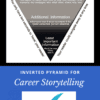
Does your resume show your past positions’ challenges, actions and results? Why it needs to.
Your resume is more than just a list of previous jobs and education. It’s the story of you and your professional life. Scratch that, it’s the story of you and your professional development.
Employers want to look at your resume and see that story loud and clear. Where have you been? What have you done? Most importantly, what have you accomplished? They don’t want to just know what you think you have learned; they want to know how you benefited your previous employers.
One of the most efficient ways to do this is by applying the C.A.R. method when building your resume. C.A.R. is the acronym for Challenge, Action, and Results.
Read on to discover how to apply the C.A.R. method to your resume and get better results in your job search.
C.A.R. Method Resume: Challenge.
Every position faces challenges. This doesn’t mean dealing with a challenging coworker, it’s about the company. What issues were they facing that they looked to you to fix? It doesn’t matter if you work in construction, payroll, or sales, all companies have their own sets of issues that they look to their employees to help solve.
For each job that you have listed on your resume, think about the tasks you were given. Each task is, in other words, a problem. Something that hasn’t been done that needs to be done. By doing the task, you’ll be solving some issue for the company. It’s not the day-to-day issues you’re looking for here, but the problems that required time, strategy, and skill to solve. Bring out those challenges on your resume. Here are some examples:
Instead of: “Researched marketing strategies.”
Try: “Tasked with improving our company’s return on investment with our marketing campaigns.”
Instead of: “Worked with front end checkout process.”
Try: “Assigned to help improve our sales-per-hour numbers at checkout.”
Instead of: “New market analysis.”
Try: “Asked to find new markets for our products in the Central QLD.”
Of course the bigger the problem, the more impressive the resume, but when you’re putting together your resume, don’t worry about that. You don’t want to make things sound bigger than they were. Just think about the real issues that were facing your company and your position and get them on your resume.
C.A.R. METHOD RESUME: Action.
Okay, so now you’ve established that you were in charge of handling a problem. What did you do about it? What strategy did you put in place to tackle the problem and why? Did you implement new policies? Did you cut wasteful spending?
The key to “Action” is keeping it short and sweet. You only have so much room on your resume and of the three items in the C.A.R. formula, the action should get the least amount of attention. Be concise and simply state what you did to improve the situation. Here are some examples:
“Shifted marketing dollars away from print and billboards to create a radio campaign integrated with social media.”
“Added a new coding system at checkout for looking up produce.”
“Researched applications for our products in schools and hospitals in central QLD.”
While this part of the equation may get the fewest words on your resume, you will need to be ready to explain it in further detail. If you get the interview, the hiring company will very likely want to know why you chose that specific strategy.
C.A.R. METHOD RESUME: Results.
This is what prospective employers really want to see. Sure, you were faced with a problem and came up with a plan to address it, but how did you do? They don’t want to hear that it “went well.” They want to see quantifiable results. Here are some examples:
“Improved ROI on marketing by 35% in the first year.”
“Sales-per-hour jumped from 23 to 38 due to faster produce lookup times.”
“Increased sales in central QLD by 78% by developing a new market with public school systems.”
Tip: Really front load the important information on these statements. Don’t hide the payoff at the end. People scan resumes and may not read every sentence to the end.
The statements like these in a C.A.R. resume show that you don’t just show up to work each day, you get things done that help the company. When faced with a challenge, you’re not afraid to dig in and create a solution.
What if your solution didn’t get great results or maybe didn’t even work at all? That’s tough to put out there on your resume, but if it’s relevant work experience, you should do so anyway. If possible, try to spin the results phrase into a positive (i.e. what you learned from it).
Example: “ROI on radio campaign was negligible because the social media campaign did not properly support it. New procedures were developed to streamline and sync campaigns.”
It’s okay to admit that a project didn’t go as planned. Do you think employers really believe that every applicant has a flawless work history? Seeing an admission of error and a secondary solution shows integrity. A prospective employer who isn’t able to recognize that is likely going to be a challenge to work for anyway.
C.A.R. METHOD RESUME: Conclusion.
When done properly, a C.A.R. resume is easy and quick to scan, but still paints a great picture of the candidate and what he or she truly brings to the table. Every job exists to help make the company better in one way or another. From keeping floors and bathrooms clean to improving networking solutions between cities, each person in the workforce is tasked with making their company better.
The C.A.R. method resume shines a spotlight on how you’ve made your companies better. Ideally, each progressive job should show bigger and more productive solutions.
Want even more incentive to boost your resume with the C.A.R. technique? Think about the interviews you’ve had in the past. There are usually some awkward moments when you’re not sure how to talk about what you actually did at a certain job. While building your C.A.R. resume, you’ll be forced to really examine your career stops and what you accomplished while you were there.
When it comes time to sit down face-to-face for that interview, you’ll be ready for just about any question they can throw at you. You’ll know your strengths, weaknesses, and most likely which projects meant the most to you and why.
Every job has a challenge. A good employee will take action to fight that problem. A great employee can talk about the amazing results they achieved with their actions. You’ve been that great employee. Make sure your resume tells that story.
Want to see how your resume stacks up? Try out our free critique today!

